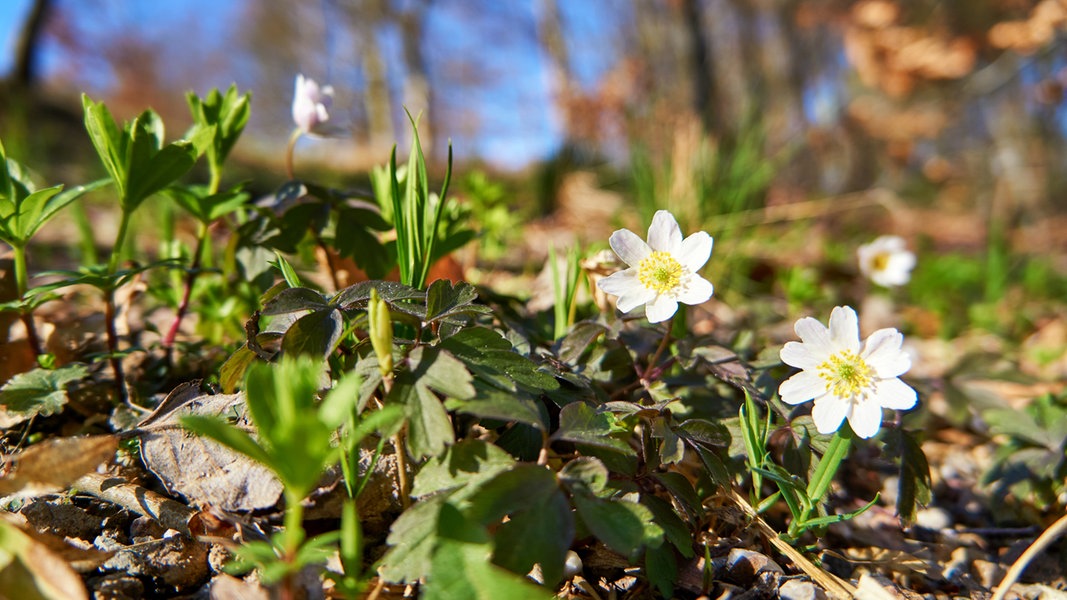As of: March 17, 2024 5:00 a.m
They provide insects with food in spring, are easy to care for and are an absolute eye-catcher: wood anemones form beautiful carpets of flowers both in the forest and in the garden. Planting tips.
Their delicate flowers are a clear sign that spring is approaching: wood anemones (Anemone nemorosa) form such large runners that huge areas are transformed into a sea of flowers that can be discovered on a walk through the forest. There the wood anemone grows in deciduous and coniferous forests. The native perennial, also known as witch flower, can also be planted in the garden.
The right location
Wood anemones need a location in the garden that corresponds to their natural distribution: they are best planted under trees that have not yet formed dense leaves in spring. A partially shaded spot is ideal. The hardy perennial retreats into the ground by early summer and sprouts again the following year.
Plant wood anemones
A partially shaded location under trees is ideal for the wood anemone.
The best time to plant wood anemones is spring. The garden soil should be permeable, loose, nutrient-rich and rather calcareous. The plant also tolerates slightly acidic soils. Single planting is not recommended; the witch flower only develops its beauty when it grows over larger areas. When planting a new plant, around 25 plants per square meter are recommended.
However, the wood anemone goes wild over time and spreads both via rhizomes (rootstocks) and seeds.
Caring for the wood anemone
Wood anemones are absolutely easy to care for and undemanding if they are in the right location. Depending on the variety, they grow ten to 25 centimeters high. Since they retreat into the ground after flowering, they do not need to be cut. For an optimal supply of nutrients, they should be mulched with leaves in autumn so that fresh humus forms. Shortly before budding in spring, add a thin layer of compost to the bed. Important: Do not till the soil around the wood anemones, otherwise the rhizomes could be injured.
Flowering time and colors of the anemone
In addition to the classic white, there are also varieties in blue, purple and even yellow.
The wild form of the anemone, which belongs to the anemone genus, produces white flowers that appear from March to April, depending on the weather. Some varieties bloom as early as February, others even until May. Insects such as wild bees and bumblebees, which are already looking for food in early spring, benefit from the early flowering time. Through breeding, in addition to the white varieties, there are also plants that bloom purple, blue, pink and even yellow. The light yellow variety “Leipziger Anemone” (Anemone x lipsiensis) is a cross between the wild form and the yellow anemone.
Wood anemones are poisonous
The Bonn Poison Center considers the wood anemone to be slightly poisonous. Touching the plant can cause skin irritation or even blistering, so you should always wear gloves when gardening. When consuming plant components, symptoms such as vomiting, diarrhea and kidney damage can occur in addition to irritation of the mucous membranes of the mouth and throat. All parts of the plant are poisonous.
Further information
When the first perennials bloom, winter is finally over. Examples of plants that beautify the bed in spring. Image gallery
The signs of spring are easy to propagate and look beautiful in combination with Christmas roses. more
Liverworts are found in old deciduous forests. But the early bloomer also provides bright colors in your own garden. more
This topic in the program:
NDR 1 Lower Saxony | Garden podcast: All carrots, or what?! | March 13, 2023 | 6:00 p.m
